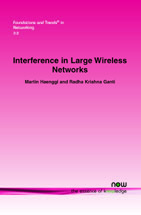Interference in Large Wireless Networks
By Martin Haenggi, Department of Electrical Engineering, University of Notre Dame, USA, mhaenggi@nd.edu | Radha Krishna Ganti, Department of Electrical Engineering, University of Notre Dame, USA, rganti@nd.edu
Abstract
Since interference is the main performance-limiting factor in most wireless networks, it is crucial to characterize the interference statistics. The two main determinants of the interference are the network geometry (spatial distribution of concurrently transmitting nodes) and the path loss law (signal attenuation with distance). For certain classes of node distributions, most notably Poisson point processes, and attenuation laws, closed-form results are available, for both the interference itself as well as the signal-to-interference ratios, which determine the network performance.
This monograph presents an overview of these results and gives an introduction to the analytical techniques used in their derivation. The node distribution models range from lattices to homogeneous and clustered Poisson models to general motion-invariant ones. The analysis of the more general models requires the use of Palm theory, in particular conditional probability generating functionals, which are briefly introduced in the appendix.
Interference in Large Wireless Networks
Interference is the main performance-limiting factor of large wireless communication systems. To analyze and design these networks, it is thus imperative that the interference is statistically characterized or bounded in the presence of various sources of uncertainty, including the users' positions, their patterns of activity, and the channel fading states. Interference in Large Wireless Networks addresses this problem using basic probability and tools from stochastic geometry. Starting with regular networks and the popular Poisson model, it discusses increasingly more general networks. In addition to the interference itself, it also derives explicit expressions for outage probabilities, which are indispensable for the optimization of higher-level metrics such as the transport capacity or end-to-end delay. Interference in Large Wireless Networks includes an appendix that reviews the underlying mathematical tools, which makes it self-contained and suitable for graduate students, researchers, and wireless engineers alike.
